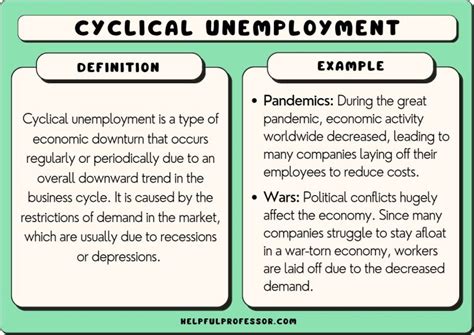Understanding Cyclical Unemployment

Cyclical unemployment, also known as demand-deficient unemployment, arises during economic downturns or recessions. It occurs when the overall demand for goods and services in an economy falls, leading to a decrease in production and a consequent reduction in labor demand.
Identifying Cyclical Unemployment
To identify cyclical unemployment, consider the following characteristics:
- Coincides with Economic Fluctuations: Cyclical unemployment rises during recessions and falls during economic expansions.
- Temporary: It is a short-term phenomenon that resolves as the economy recovers.
- Skill-Specific: Cyclical unemployment often affects specific industries or sectors that are vulnerable to economic downturns, such as manufacturing or construction.
Example of Cyclical Unemployment
A classic example of cyclical unemployment is the situation experienced during the Great Recession of 2008-2009. As the housing market collapsed and credit tightened, demand for goods and services plummeted. This led to widespread layoffs in the construction, financial, and automotive sectors, resulting in a significant increase in cyclical unemployment.
Other Examples
Other examples of cyclical unemployment include:
- Unemployment caused by a decline in consumer spending during an economic recession.
- Job losses in manufacturing due to a slowdown in global demand.
- Layoffs in the travel and hospitality industry during a economic downturn.
Distinguishing Cyclical from Other Types of Unemployment
Cyclical unemployment is distinct from other types of unemployment, including:
- Frictional Unemployment: Short-term unemployment experienced during job transitions or career changes.
- Structural Unemployment: Long-term unemployment caused by technological advances or changes in industry demand.
- Seasonal Unemployment: Temporary unemployment occurring during specific periods of the year, such as the winter months in construction.
Consequences of Cyclical Unemployment
Cyclical unemployment has significant individual and economic consequences:
- Economic Loss: Lost production and income for individuals and businesses.
- Increased Poverty: Cyclical unemployment can lead to increased poverty rates and financial hardship.
- Skills Erosion: Prolonged unemployment can lead to skills deterioration and reduced employability.
Addressing Cyclical Unemployment
Governments and policymakers can implement various measures to address cyclical unemployment, such as:
- Fiscal Stimulus: Increasing government spending to boost demand and create jobs.
- Monetary Policy: Lowering interest rates to encourage borrowing and investment.
- Job Training Programs: Providing training and retraining opportunities to help workers transition to new industries.
Understanding and addressing cyclical unemployment is crucial for promoting economic stability and reducing its negative consequences on individuals and society.
